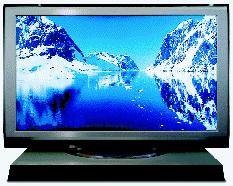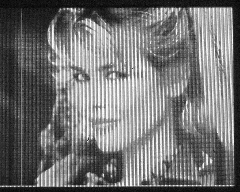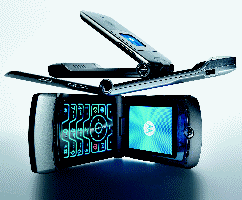Tenth Annual Display of the Year Awards Announced at SID '05
The winners of the 2004 Display of the Year Awards were announced at the SID '05 Keynote Session, at which the awards were presented.
by Ken Werner
THE Display of the Year Awards (DYAs), sponsored by the Society for Information Display and Information Display magazine, were presented during the Keynote Session on the morning of Tuesday, May 24, 2005, at the SID International Symposium, Seminar, and Exhibition in Boston.
The Display of the Year Awards Committee (DYAC) – and international committee comprised of leading members of the technical display community and distinguished technology journalists – honored six exceptional achievements in display technology, display systems, and display components and materials.
In order to be considered for a 2004 award, descriptions of candidate products had to be submitted between July 1, 2003, and October 31, 2004. Nominations were submitted by DYAC members as well as other parties; company self-nominations were also accepted. All nominations were given equal consideration.
Gold and Silver Awards are voted in three categories: Display of the Year, Display Product of the Year, and Display Material or Component of the Year. The DYAC bylaws require the committee members to consider many factors in their deliberations, including technical innovation, commercial significance, and likely social impact.
Display of the Year
Gold Award: LG.Philips LCD's 55-in. LCD Module
When it was first sold in volume to television-set manufacturers in 2004, the LG.Philips LCD 55-in. 1929 x 1080-pixel LCD module was the largest of its kind commercially available. Large LCDs present special design challenges, which LG.Philips LCD met with a variety of technologies. The company's Super In-Plane-Switching (SIPS) cell technology produces a wide viewing angle without the use of compensation film, as well as a contrast ratio and colors that shift very little with changes in viewing angle.
The module uses an overdriving circuit (ODC), and, coupled with the cell design and a blinking backlight, produces an effective response time of 8 msec between gray levels and minimizes blurring of moving images. The incorporation of a dynamic contrast ratio (DCR), which reduces the maximum backlight luminance for dark scenes and simultaneously expands the signal level so that more gray levels are available in dark scenes, improves the detail visible in dark scenes and expands the contrast ratio to 1200:1. An equivalent expansion in bright scenes also contributes to the reduction in backlight luminance.
A variety of processes that reduce manufacturing cost were also implemented. The company's Vacuum Alignment with Liquid Crystal (VALC) filling process reduces the time to fill a panel from many hours to just a few minutes.
For developing the first commercially available TFT-LCD module for television sets in the mid-50-in. range, and for meeting the challenges of designing large TFT-LCD modules for television applications by employing a variety of innovative technologies, the DYAC presented the 2004 Display of the Year Gold Award to LG.Philips LCD.
Silver Award: Nemoptic's BiNem® Bistable LCD
In many portable products, a significant amount of energy from the battery is consumed by continually refreshing the display. This has motivated a strong interest over the years in bistable display technologies – technologies that will hold an image on the display without consuming energy after the display is addressed. When bistability is combined with a reflective technology – one that does not require a backlight – the display requires no power at all except when the image is being changed.
Nemoptic has developed a bistable variation on the classic supertwisted-nematic liquid-crystal display (STN-LCD), so the technology is compatible with existing STN-LCD manufacturing lines. In Nemoptic's BiNem® architecture, the liquid-crystal material is strongly anchored to one plate of the LCD "sandwich" and weakly anchored to the other. The weak anchoring can be broken by applying a pulse of about 15 V. If the pulse has a gradually falling edge, the liquid crystal relaxes into an untwisted state, but if the pulse falls rapidly, the liquid crystal winds up in a 180° twisted state. Both states are stable untilanother pulse is applied to break the anchoring.
Nemoptic has demonstrated color and gray-level capability for the BiNem® technology, but it was the black-and-white VGA version of the display currently being manufactured and integrated into e-books by Nemoptic licensee Picvue that moved the DYAC to present the 2004 Display of the Year Silver Award to Nemoptic.
|
DISPLAY OF THE YEAR

Gold Award: LG.Philips LCD's 55-in. 1929 x 1080-pixel LCD module was the largest of its kind when introduced in 2004.

Silver Award: Nemoptic's BiNem® bistable black-and-white VGA LCD is currently being manufactured and integrated into e-books.
|
Display Product of the Year
Gold Award: Sony's LIBRIé eBook
A wave of e-books in the 1990s passed without leaving much of a lasting impact, in part because the sufficiently economical LCDs available at the time were small, dim, lacked sufficient pixel density, and drew down their batteries at too rapid a rate.
Now, Sony Corp. has reinvigorated the category by integrating a bistable electro-phoretic "electronic paper" display from the team of E-Ink Corp. and Philips into its LIBRIé eBook. The display is about 6 in. (152 mm) on the diagonal (active area) and has a resolution of 800 x 600 pixels, resulting in a pixel density of 170 ppi. The pixel density is sufficient for a smooth rendering of Chinese characters.
The eBook's display is reflective, and has a contrast ratio of 10:1 and a 2-bit gray scale (four levels, including black and white). Its 35% reflec-tance produces a good white point and a reading experience that is much closer to that of a print-on-paper book than was true of previous eBooks.
The system is compact and thin at 126 mm (W) x 190 mm (H) x 13 mm (D), and light in weight at 190 grams (without its four AAA batteries). About 20 e-books can be stored in the LIBRIé's 10-MB internal memory, and additional e-books can be carried on Memory-Stick PRO flash-memory storage cards.
For incorporating novel display technology in the design of an e-book that is more appealing to consumers, and which brings the e-book closer to fulfilling its potential, the DYAC presented Sony Corp. with the 2004 Display Product of the Year Gold Award.
Silver Award: Motorola's RAZR V3 Cellular Telephone
Motorola's RAZR V3 brings stunning industrial design to premium cellular telephones, with an anodized aluminum case that is only 13.9 mm thick and has a total weight of only 95 grams. The chemically etched keypad is created from a single sheet of nickel-plated copper alloy and is illuminated by an electroluminescent panel.
Within this elegant package, Motorola has not only included a bright 2.2-in. 176 x 220-pixel 64k-color main display and a 96 x 80-pixel 4k-color secondary display, but also MPEG 4 video playback, a VGA camera, full quad-band GSM, Bluetooth® wireless tech-nology, a built-in speakerphone, and PIM functionality.
For raising the ubiquitous cellular telephone to new levels of elegance and functionality, the DYAC presented Motorola with the 2004 Display Product of the Year Silver Award.
|
DISPLAY PRODUCT OF THE YEAR

Gold Award: Sony Corp.'s LIBRIé eBook incorporates a 6-in. 800 x 600-pixel bistable electrophoretic display from the team of E-Ink Corp. and Philips.

Silver Award: Motorola's RAZR V3 cellular telephone includes MPEG 4 video playback, a VGA camera, full quad-band GSM, Bluetooth®, a built-in speakerphone, and PIM functionality.
|
Display Material or Component of the Year
Gold Award: E-Ink Corp.'s Microencapsulated Electrophoretic Front-Plane Laminate (FPL) for Paper-like Displays
Electrophoretic displays – displays based on the motion of charged particles in an electric field – have been under development since the 1980s. E-Ink Corp. has solved a number of difficulties by enclosing the charged particles and the liquid medium in which they move within microcapsules, which can then be easily applied to a substrate. But E-Ink Corp. has gone farther than that. Early electro-phoretic approaches (and some current ones) used a single type of colored charged particle within a colored liquid medium. When the particles were attracted to the viewing side of the display, the viewer saw the color of the particles. When the particles were attracted to the opposite side of the display, the viewer saw the color of the liquid medium .
E-Ink Corp. developed a system that uses both positive and negative particles, depending on the polarity of the charge; either the black or white particles can be attracted to the viewing side of the display for an achromatic display with paper-like viewing qualities.
Working with partner Philips, E-Ink has now commercialized a display based on its front-plane laminate, which now exhibits two levels of gray in addition to black and white, with all levels being stable when power is removed. How a state that intermingles positive and negative charges in a fluid medium within a microcapsule can be stable is a trade secret that E-Ink Corp. has been careful not to reveal, but the result is impressive.
For substantial innovation in the science and technology of electrophoretic front planes, the DYAC presented E-Ink Corp. with the 2004 Display Material or Component of the Year Gold Award.
Silver Award: Lumileds Lighting's Luxeon LED Module for Backlights
Cold-cathode fluorescent lamps (CCFLs) are the standard lighting source for the backlights used in LCD notebook computers, desktop monitors, and TV sets. Unfortunately, more than 90% of the light from the backlight never makes it through the LCD and the matrix color filter (MCF) to the viewer's eyes. If the red, green, and blue areas on the MCF are made more dense, a wider range (or gamut) of colors can be displayed, but even less light reaches the viewer's eyes. Alternatively, a brighter more-expensive backlight that uses more power can be used. The standard compromise used today for LCD TVs is a gamut that is 72% of that specified by the old National Television System Committee (NTSC).
But over the last few years, Lumileds Lighting, LLC, has developed a way to make a practical backlight using assemblies of high-output light-emitting diodes (LEDs) that produces a broader gamut than a CCFL backlight for the same MCF transmissivity. The company calls its assemblies Luxeon modules.
The modules are currently being used in the Sony Qualia 005 46-in. LCD TV, in which they produce a color gamut that is 105% of the NTSC standard – a striking and clearly visible improvement over the current standard.
At least one other manufacturer has introduced an LCD TV with an LED backlight, and at least one other manufacturer has introduced an LED backlight for sale to LCD manufacturers, but it is Lumileds Lighting that led the way.
For pioneering practical LED-backlight modules for LCDs, the DYAC presented the 2004 Display Material or Component of the Year Silver Award to Lumileds Lighting, LLC. •
|
DISPLAY MATERIAL OR
COMPONENT OF THE YEAR

Gold Award: E-Ink Corp.'s microencapsulated electrophoretic front-plane laminate (FPL) is used in paper-like displays.

Silver Award: Lumileds Lighting's Luxeon LED modules are a substitute for CCFL backlights.
|
|
2004 DISPLAY OF THE YEAR AWARDS COMMITTEE
|
|
Dr. Ernst Lueder, Chair
Professor Emeritus, Stuttgart University
Scottsdale, Arizona, U.S.A.
Mr. Alain Boissier
Nemoptic
Magny les Hameaux, France
Mr. Stewart Hough
ATA
Madera, California, U.S.A.
Professor Shunsuke Kobayashi
Founding Chair
Science University of Tokyo in Yamaguchi
Yamaguchi, Japan
Professor Jin Jang
Kung Hee University
Seoul, Korea
Mr. David Lieberman
Freelance Journalist
Waltham, Massachusetts, U.S.A.
|
Mr. Makoto Maeda
Maeda Consulting
Yokohama, Japan
Mr. David Mentley
Display Industry Consultant
El Sobrante, California, U.S.A.
Professor Shigeo Mikoshiba
The University of Electro-Communications
Tokyo, Japan
Dr. Alan Mosley
Display Industry Consultant
Hertfordshire, U.K.
Mr. Jean-Noel Perbet
THALES Avionics – ATA
Le Haillan, France
Mr. Alfred Poor
PC Magazine
Perkasie, Pennsylvania, U.S.A.
|
Professor Heiju Uchiike
Saga University
Saga, Japan
Dr. I-Wei Wu
Toppoly Optoelectronics Corp.
Taiwan, R.O.C.
Mr. Kenneth I. Werner
Editor
Information Display
Norwalk, Connecticut, U.S.A.
For further information, please communicate with the Committee Secretariat:
Dian Mecca
Nutmeg Consultants
telephone 203/853-7069
fax 203/855-9769
e-mail: dmecca@nutmegconsultants.com
|
Ken Werner is the Editor of Information Display.
The opinions expressed in this article are not necessarily those of the Publisher ofInformation Display
Magazine or of the Society for Information Display.